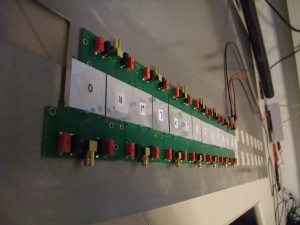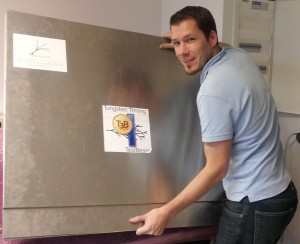Good timing is a virtue. Just as comedians have to wait for just the right moment to deliver their punch line, linear collider physicists need to know when to make cuts. These cuts separate phenomena called particle showers from each other, making it possible for the physicists to tell which reaction originated from which collision. Two German PhD students have built a test device that is supposed to get behind the precise timing of showers.
The calorimeter currently under study by the CALICE collaboration for a future CLIC detector is using tungsten because the density of the material would make the final calorimeter much more compact than any other absorber material. However, tungsten has the annoying habit of emitting neutrons from time to time, and these neutrons would jumble the results from the hadronic calorimeter because the energy bill would not add up. In order to keep the balance right, physicists need to be able to pair collision and particle shower, thus ‘timestamping’ the shower. The better they know their particle showers, the easier it is for them to tell where to separate one from the other.

The row of scintillator tiles for the T3B experiment's timing measurements. Image: Christian Soldner
This is where PhD student Christian Soldner and his colleague Lars Weuste, both working at the Max-Planck-Institute for Physics in Munich, Germany, come in. Fifteen silicon photomultipliers or SiPMs, each attached to a scintillator tile and connected to four oscilloscopes with extremely high time resolution, make up their test device called “T3B”, for tungsten timing test beam. “We can tell with a precision of about one nanosecond when a SiPM pixel has fired because it was hit by a photon,” says Soldner. “The trick is to really understand hadronic showers by knowing exactly how much energy was deposited where and at precisely which time – sort of a high resolution in 4D.”
Under the supervision of MPI’s Frank Simon, the pair designed and built the T3B device, ran simulations, wrote the code and tested it in test beams at CERN together with the CALICE analogue HCal and the semi-digital HCal. They started in 2010 and have collected a lot of data with different absorber materials, with first analyses looking interesting not only for them, but also for the makers of the GEANT4 simulation software and even the organisers of the IEEE conference in Valencia last year – Christian Soldner won one of four ‘Best Student Paper’ prizes at the IEEE for the presentation of their results so far.
By the end of next year, Soldner will have analysed all the data and written his PhD about the results. He’s keeping an open mind about what to do next: “I might look at post-doc options, for example at CERN, but I also think that project work in the industry can be really fascinating,” says the 28-year-old from Munich.
Read more in Frank Simon’s blog



Recent Comments